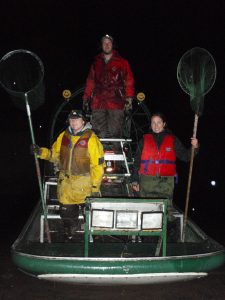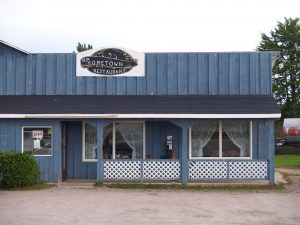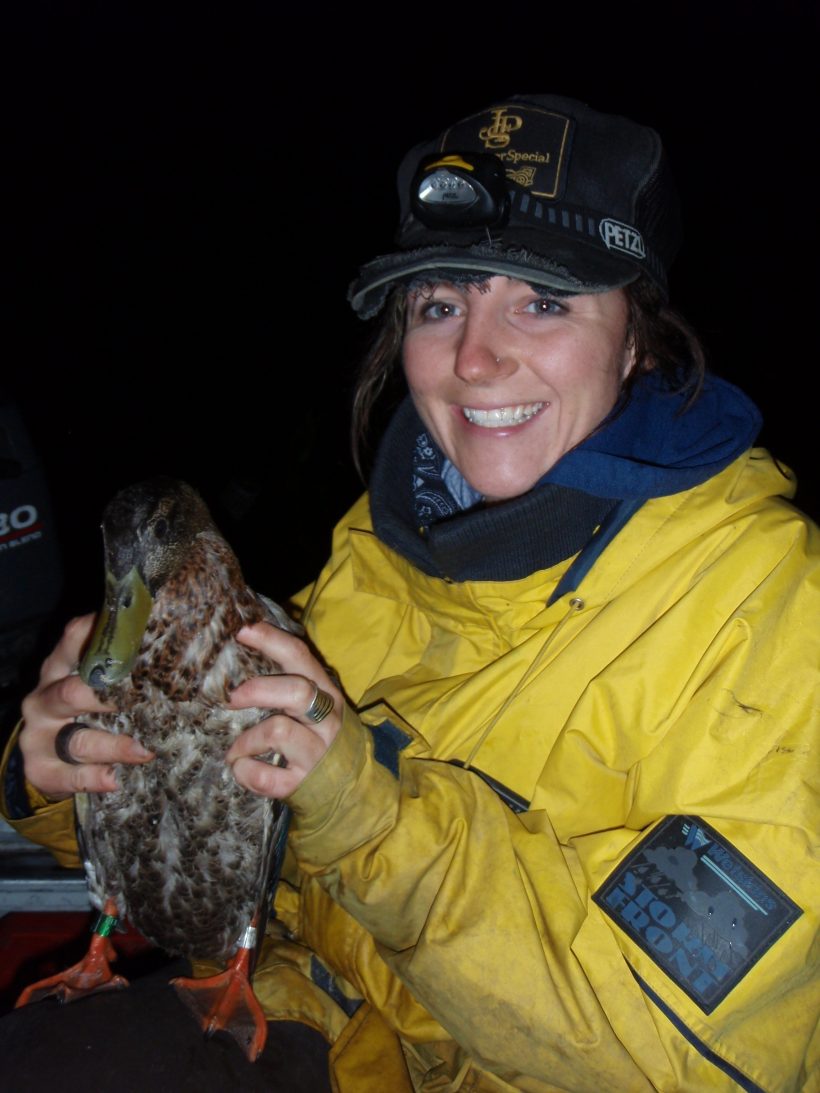DUCK BANDING on the CONROY MARSH
A Scotch mist descended as I pulled out of the driveway at 5 p.m. to join an MNR crew for some nighttime duck banding on the Conroy Marsh. On the way to meet the team at Palmer Rapids torrential rains began to dampen my enthusiasm. Over supper at Our Hometown Restaurant Matthew Purvis, MNR Research Technician and boat Captain, told me that the previous evening they had a 3rd year F&W class from Sir Sandford Fleming out banding ducks in the Baptiste/Elephant Lake area until 4:30 a.m. They had, he said, managed to band about 40 ducks, an excellent night for the students to gain some exposure. Looking out the window I noticed some rays of sunshine breaking up the cloud cover and secretly hoped my exposure would be sunnier than wet.
We traveled in convoy to the boat launch and I almost managed to fill my deer tag – which wouldn’t have been a good thing. Out of nowhere a deer blasted off the bow of my car through the opening of the parade like a middle linebacker totally focused on the quarterback mindless of any blockers. At the launch, with dusk rapidly settling in, Doug Skeggs, a Communications Officer with Pembroke District MNR, launched the banding boat. Other than Purvis and his assistant Stacy Gan, an OMNR Technician and Trent U. grad student, all were volunteering their time. “We couldn’t do this without volunteers,” said Purvis.

With darkness settling in, Purvis launched the Everglades Airboat to some background music from Eric Clapton and Led Zeppelin. That’s when I noticed Skeggs bailing the banding boat. An occupational hazard when the plug is not properly placed.
I joined Skeggs and Shandy Labine, an Ontario Stewardship Crew Leader, in the banding boat as we headed for the interior. Skeggs used a spotlight in the pitch black to find the appropriate channels. Rounding one bend we spooked some deer feeding by the river’s edge. Finally we landed at what proved to be a floating bog. There would be no getting out and stretching tonight without some very wet consequences! By now the sky was starlit. The Big Dipper orientated us and we could see evidence of a storm in the far West North West. Soon we heard the roar of the Everglade airboat powered by a 350 Chevy engine. The 16 footer has a fiberglass hull with a Teflon skid plate ideal for scooting over the marsh. Only once did we find ourselves stuck in mud and Stacy, wearing hip waders, pushed us off.
The Captain sits in a high chair to the rear and two crew stand at the bow – one port, one starboard – armed with a net attached to a very long pole. As we raced about the marsh seeking to capture ducks the Captain would flash a spotlight to indicate quarry. Purvis described the netting motion as similar to the “J” stroke used by canoeists. Place the net over the duck, pull back and twist the wrist to capture. Once aboard we would gently place the bird in a cage. Sounds easy but combine speed, darkness and sometimes “turn on a dime” maneuvers and you discover it “T’aint so.”
“Every year someone falls off the boat,” said Purvis. We were determined not to be that “someone”.
Once we had birds we returned to the banding boat to exchange ducks for empty cages and a new crew. Waiting in the banding boat seemed like an eternity waiting for the airboat to return. On the airboat you wondered where the time went.
By evening’s end we had managed to band some 50 ducks. A few of the ducks were released with 2 bands. One band was the regular affixed to all ducks and the 2nd was the $100 band. Any hunter shooting one of these ducks could phone in the numbers and claim the prize. When a hunter shoots a banded duck s/he then phones in the band information and, in return, learns the history of the bird. The hunter may also request a certificate complete with the bird’s background. Skeggs had forgotten his glasses so I became a scribe and Gan taught our two other volunteers from Palmer Rapids, Amanda and Lynsay Phanenhour, how to band.
On the last run of the night I was so rapt in concentration focused on ducks that I hadn’t noticed that the sky had clouded over and it was pouring rain. Of course my rainwear was on the banding boat.
Back at the launch site we finished banding and releasing the ducks while extricating the boats. Head lamps lights were especially effective in warding off the darkness.
Other essential gear not already mentioned included layers of clothing. When sitting in the duck boat you tend to become chilled. When on the airboat chasing ducks you can get overheated. Rubber gloves are a bonus. Of course we all wore the provided protective ear muffs and lifejackets. Purvis and Gan were always cheerful, encouraging, patient and informative – must qualities for the program.

The Airboat Project is under the direction of Chris Davies, Manager of Wildlife Research & Development in Peterboro. It ran experimentally from 1994-96 and has been operational since 1997. Annually it runs from approximately August 20 to September 23 in North East and Southern Ontario. All data is entered into both Canadian and U.S. banding records and is used for waterfowl management. The banding data can also be used to map migration routes and to measure mortality and survival rates. The project costs approximately $60,000 annually and is 80% funded by Flyway dollars from both the Atlantic and Mississippi Flyway Councils and 20% from the MNR.
The Conroy Marsh is a 2400 hectare wetland. Three rivers – the Madawaska, York and Little Mississippi meet there. Purvis and Gan plotted our trips with both map and GPS. We were in constant communication by radio and amongst all of the first aid equipment we had a couple of satellite phones complete with directions.
I pulled into my driveway at 6:30 a.m. my biorhythms shot to blazes. Without doubt this is a youngun’s pursuit.
PHOTO- 6a. Gan & the $100 duck; 6b. restaurant; 6c- Crew- back – Captain Purvis; Front – left – Gan, Rt. Labine
First published 2010
